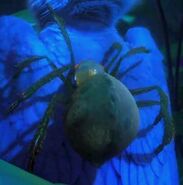Tarantulas comprise a group of large and often hairy arachnids belonging to the Theraphosidae family of spiders, of which about 900 species have been identified. This article only describes members of the Theraphosidae, although some other members of the same infraorder (Mygalomorphae) are commonly referred to as "tarantulas". Some species have become popular in the exotic pet trade. New World species kept as pets have urticating hairs that can cause irritation to the skin and, in extreme cases, cause damage to eyes.
One appears in the first film, this one being a subspecies to the Black Widow, after Blu and Jewel escaped from the smugglers, in the jungle just outside Rio. Blu, not comfortable in jungles, claims he has a spider on his back after walking between some leaves. Jewel, clearly annoyed by his constant complaining says, "It's just a leaf, turn around!" When Blu does so, Jewel sees that he really does have a spider on his back, and she quickly flicks it off and says: "Leaf! Told ya!"
In the second movie, this time a tarantula, Tiago was using it to scare his father awake, laughing afterward along with the other Spix's Macaw children. A similar spider appeared in the song "Batucada Familia," when Jewel asked Blu if he was sure about staying in the jungle. Blu replies that he is "Mr. Jungle," and totally wild and very birdly only to be scared by a spider just some seconds later, Jewel then says that maybe they can do summers in Rio.
Overview[]
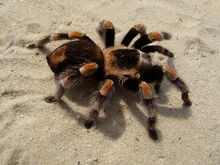
Mexican Red-kneed Tarantula, Mexican Red-kneed birdeater. Female (Brachypelma smithi)
Like all arthropods, the tarantula is an invertebrate that relies on an exoskeleton for muscular support. Like other Arachnida, a tarantula’s body comprises two main parts, the prosoma (or cephalothorax) and the opisthosoma (or abdomen). The prosoma and opisthosoma are connected by the pedicel or pregenital somite. This waist-like connecting piece is actually part of the prosoma and gives the opisthosoma a wide range of motion relative to the prosoma.
Tarantula sizes range from as small as a fingernail to as large as a dinner plate when the legs are fully extended.
Depending on the species, the body length of tarantulas ranges from 2.5 to 10 cm (1 to 4 in), with leg spans of 8–30 centimeter (3–12 in). Leg span is determined by measuring from the tip of the back leg to the tip of the front leg on the opposite side. Some of the largest species of tarantula may weigh over 85 g (3 oz); the largest of all, the goliath birdeater (Theraphosa Blondi) from Venezuela and Brazil, has been reported to attain a weight of 170 g (6.0 oz) and a leg-span up to 30 cm (12 in), males being longer and females greater in girth. The fang size of this tarantula reaches a maximum of 3.8 cm (1.5 in).
Theraphosa apophysis (the pinkfoot goliath) was described 187 years after the goliath birdeater, so its characteristics are not as well attested. Theraphosa Bondi is generally thought to be the heaviest tarantula, and T. apophysis to have the greatest leg span. Two other species, Lasiodora Parahybana (the Brazilian salmon birdeater) and Lasiodora Klugi, rival the size of the two goliath spiders.
Most species of North American tarantulas are brown. Elsewhere, species have been found that variously display cobalt blue (Cyriopagopus lividus), black with white stripes (Aphonopelma seemanni), yellow leg markings (Eupalaestrus campestratus), metallic blue legs with a vibrant orange abdomen and green prosoma (Chromatopelma cyaneopubescens). Their natural habitats include savanna, grasslands such as the pampas, rainforests, deserts, scrubland, mountains, and cloud forests. They are generally classed among the terrestrial types. They are burrowers that live in the ground.
Tarantulas are becoming increasingly popular as pets, and some species are readily available in captivity.
Etymology[]
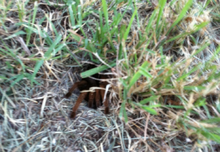
Tarantula at the mouth of its burrow
The spider originally bearing the name "tarantula" was Lycosa tarantula, a species of wolf spider native to
Mediterranean Europe. The name derived from that of the southern Italian town of Taranto. The term "tarantula" subsequently was applied to almost any large, unfamiliar species of ground-dwelling spider, in particular to the Mygalomorphae and especially to the New World Theraphosidae. Compared to tarantulas, wolf spiders are not particularly large or hairy, so among English speakers, in particular, the usage eventually shifted in favour of the Theraphosidae, though they are barely related to the wolf spiders, being in a different infraorder.
New World and other divergent usages[]
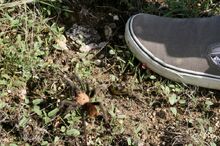
A tarantula next to a US size 11 shoe, to show scale, taken near Austin, Texas
When theraphosids were encountered in the Americas, they were named "tarantulas", causing usage of the term to shift to the tropical spiders. Nevertheless, these spiders belong to the suborder Mygalomorphae and are not closely related to wolf spiders.
The name "tarantula" is also incorrectly applied to other large-bodied spiders, including the purseweb spiders or atypical tarantulas, the funnel-webs (Dipluridae and Hexathelidae), and the "dwarf tarantulas". These spiders are related to tarantulas (all being mygalomorphs), but are classified in different families. Huntsman spiders of the family Sparassidae have also been termed "tarantulas" because of their large size. In fact, they are not related, belonging to the suborder Araneomorphae.
Distribution[]
Tarantulas of various species occur throughout the United States, Mexico, in Central America, and throughout South America. Other species occur variously throughout Africa, much of Asia, and all of Australia. In Europe, some species occur in Spain, Portugal, Turkey, south Italy, and Cyprus.
Habits[]
Some genera of tarantulas hunt prey primarily in trees; others hunt on or near the ground. All tarantulas can produce silk – while arboreal species typically reside in a silken "tube tent", terrestrial species line their burrows with silk to stabilize the burrow wall and facilitate climbing up and down. Tarantulas mainly eat large insects and other arthropods such as centipedes, millipedes, and other spiders, using ambush as their primary method of prey capture. Armed with their massive, powerful chelicerae tipped with long chitinous fangs, tarantulas are well-adapted to killing other large arthropods. The biggest tarantulas sometimes kill and consume small vertebrates such as lizards, mice, bats, birds, and small snakes.
Appendages[]
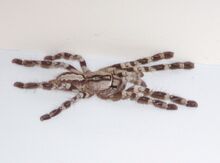
Subadult female Poecilotheria regalis
The eight legs, the two chelicerae with their fangs, and the pedipalps are attached to the prosoma. The chelicerae are two double-segmented appendages located just below the eyes and directly forward of the mouth. The chelicerae contain the venom glands that vent through the fangs. The fangs are hollow extensions of the chelicerae that inject venom into prey or animals that the tarantula bites in defense, and they are also used to masticate. These fangs are articulated so that they can extend downward and outward in preparation to bite ,or can fold back toward the chelicerae as a pocket knife blade folds back into its handle. The chelicerae of a tarantula completely contain the venom glands and the muscles that surround them, and can cause the venom to be forcefully injected into prey.
The pedipalpi are two six-segmented appendages connected to the thorax near the mouth and protruding on either side of both chelicerae. In most species of tarantula, the pedipalpi contains sharp, jagged plates used to cut and crush food, often called the coxae or maxillae. As with other spiders, the terminal portions of the pedipalpi of males functions as part of their reproductive system. Male spiders spin a silken platform (sperm web) on the ground, onto which they release semen from glands in their opisthosoma. Then they insert their pedipalps into the semen, absorb the semen into the pedipalps, and later insert the pedipalps (one at a time) into the reproductive organ of the female, which is located in her abdomen. The terminal segments of the pedipalps of male tarantulas are moderately larger in circumference than those of a female tarantula. Male tarantulas have special spinnerets surrounding the genital opening. Silk for the sperm web of the tarantula is exuded from these special spinnerets.
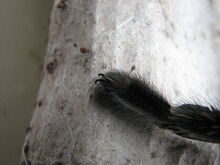
Claws at the end of the leg of Lasiodora parahybana
A tarantula has four pairs of legs and two additional pairs of appendages. Each leg has seven segments, which from the prosoma out, are: coxa, trochanter, femur, patella, tibia, tarsus and pretarsus, and claw. Two or three retractable claws at the end of each leg are used to grip surfaces for climbing. Also on the end of each leg, surrounding the claws, is a group of hairs. These hairs, called the scopula, help the tarantula to grip better when climbing surfaces such as glass. The fifth pair are the pedipalps, which aid in feeling, gripping prey, and mating in the case of a mature male. The sixth pair of appendages are the chelicerae and their attached fangs. When walking, a tarantula's first and third leg on one side moves at the same time as the second and fourth legs on the other side of its body. The muscles in a tarantula's legs cause the legs to bend at the joints, but to extend a leg, the tarantula increases the pressure of hemolymph entering the leg.
Tarantulas, like almost all other spiders, have their primary spinnerets at the end of the opisthosoma. Unlike most spider species in the suborder Araneomorphae, which includes the majority of extant spider species, and most of which have six, tarantula species have two or four spinnerets. Spinnerets are flexible, tube-like structures from which the spider exudes its silk. The tip of each spinneret is called the spinning field. Each spinning field is covered by as many as 100 spinning tubes through which silk is exuded. As the silk is pulled out of the spinnerets, the shear forces cause proteins in the silk to crystallize, transforming it from a liquid to a solid thread.
Digestive system[]
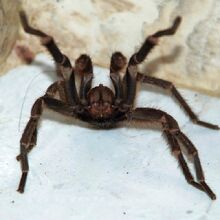
Brazilian tarantula in defensively threatening position
The tarantula's mouth is located under its chelicerae on the lower front part of its prosoma. The mouth is a short, straw-shaped opening that can only suck, meaning that anything taken into it must be in liquid form. Prey with large amounts of solid parts, such as mice, must be crushed and ground up or predigested, which is accomplished by coating the prey with digestive juices secreted from openings in the chelicerae.
The tarantula's digestive organ (stomach) is a tube that runs the length of its body. In the prosoma, this tube is wider and forms the sucking stomach. When the sucking stomach's powerful muscles contract, the stomach is increased in cross-section, creating a strong sucking action that permits the tarantula to suck its liquefied prey up through the mouth and into the intestines. Once the liquefied food enters the intestines, it is broken down into particles small enough to pass through the intestine walls into the hemolymph (bloodstream), where it is distributed throughout the body. After feeding, the leftovers are formed into a small ball by the tarantula and thrown away. In a terrarium, they often put them into the same corner.
Nervous system[]
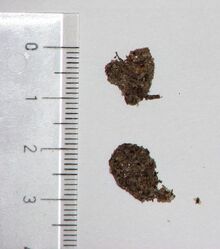
Tarantula food leftovers
A tarantula's central nervous system (brain) is located in the bottom of the inner prosoma. A tarantula perceives its surroundings primarily via sensory organs called setae (hairs or spines). Although a tarantula has eight eyes like most spiders, touch is its keenest sense, and in hunting, it primarily depends on vibrations given off by the movements of its prey. A tarantula's setae are very sensitive organs and are used to sense chemical signatures, vibrations, wind direction, and possibly even sound. Tarantulas are also very responsive to the presence of certain chemicals such as pheromones.
The eyes are located above the chelicerae on the forward part of the prosoma. They are small and usually set in two rows of four. Most tarantulas are not able to see much more than light, darkness, and motion. Arboreal tarantulas generally have better vision compared with terrestrial tarantulas.
Respiratory system[]
All types of tarantulas have two sets of book lungs (breathing organs); the first pair is located in a cavity inside the lower front part of the abdomen near where the abdomen connects to the cephalothorax, and the second pair are slightly farther back on the abdomen. Air enters the cavity through a tiny slit on each side of and near the front of the abdomen. Each lung consists of 15 or more thin sheets of folded tissue arranged like the pages of a book. These sheets of tissue are supplied by blood vessels. As air enters each lung, oxygen is taken into the bloodstream through the blood vessels in the lungs. Needed moisture may also be absorbed from humid air by these organs.
Circulatory system[]
A tarantula’s blood is unique (not only by appearance); an oxygen-transporting protein is present (the copper-based hemocyanin), but not enclosed in blood cells such as the erythrocytes of mammals. A tarantula’s blood is not true blood, but rather a liquid called hemolymph. At least four types of hemocytes, or hemolymph cells, are known. The tarantula’s heart is a long, slender tube located along the top of the opisthosoma. The heart is neurogenic as opposed to myogenic, so nerve cells instead of muscle cells initiate and coordinate the heart. The heart pumps hemolymph to all parts of the body through open passages often referred to as sinuses, and not through a circular system of blood vessels. If the exoskeleton is breached, loss of hemolymph will kill the tarantula, unless the wound is small enough that the hemolymph can dry and close the wound.
Predators[]

Eye ports seen in an exuvia (molted skin)
Regardless of their fearsome reputation, tarantulas themselves are an object of predation. The most specialized of these predators are large members of the wasp family Pompilidae such as the wasp Hemipepsis ustulata. These wasps are called "tarantula hawks". The largest tarantula hawks, such as those in the genus Pepsis, track, attack, and kill large tarantulas. They use olfaction to find the lair of a tarantula. The wasp must deliver a sting to the underside of the spider's cephalothorax, exploiting the thin membrane between the basal leg segments. This paralyzes the spider, and the wasp then drags it back into its burrow before depositing an egg on the prey's abdomen. The wasp then seals the spider in its burrow and flies off to search for more hosts. The wasp larva hatches and feeds on the spider's inessential parts and, as it approaches pupation, it consumes the remainder. Other arthropods, such as giant centipedes, are also known to prey on tarantulas.
Humans are also predators of tarantulas. They are considered a delicacy in certain cultures (e.g. Venezuela and Cambodia). They can be roasted over an open fire to remove the hairs (described further below) and then eaten.
Tarantulas have evolved specialized hairs to defend themselves against predators. Besides the normal "hairs".
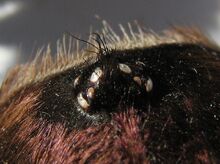
Closeup of a tarantula's eyes
covering the body, some tarantulas also have a dense covering of irritating hairs called urticating hairs, on the opisthosoma, that they sometimes use as protection against enemies.[9] These hairs are present on New World species, but not on specimens from the Old World. Urticating hairs are usually kicked off the abdomen by the tarantula, but some may simply rub the abdomen against the target, like the Avicularia genera. These fine hairs are barbed and serve to irritate. They can be lethal to small animals such as rodents. Some people are sensitive to these hairs, and develop serious itching and rashes at the site. Exposure of the eyes and respiratory system to urticating hairs should be strictly avoided. Species with urticating hairs can kick these hairs off; they are flicked into the air at a target using their back pairs of legs. Tarantulas also use these hairs for other purposes, such as to mark territory or to line their shelters (the latter such practice may discourage flies from feeding on the spiderlings). Urticating hairs do not grow back, but are replaced with each molt. The intensity, number, and flotation of the hairs depends on the species of tarantula.
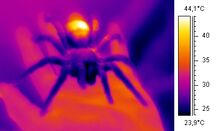
Thermal image of an ectothermic tarantula on an endothermic human hand
To predators and other enemies, these hairs can range from being lethal to simply being a deterrent. With humans, they can cause irritation to eyes, nose, and skin, and more dangerously, the lungs and airways, if inhaled. The symptoms range from species to species, from person to person, from a burning itch to a minor rash. In some cases, tarantula hairs have caused permanent damage to human eyes.
Some setae are used to stridulate, which makes a hissing sound. These hairs are usually found on the chelicerae. Stridulation seems to be more common in Old World species.
Bites and urticating bristles[]
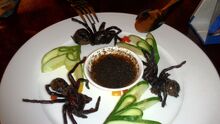
Fried tarantula in a Cambodian restaurant
Though all tarantulas are venomous, and some bites cause serious discomfort that might persist for several days, so far no bite has been reported to cause a human fatality. In general, the effects of the bites of all kinds of tarantula are not well known. While the bites of many species are known to be no worse than a wasp sting, accounts of bites by some species are reported to be very painful and to produce intense spasms that may recur over a period of several days; the venom of the African tarantula Pelinobius muticus also causes strong hallucinations. For Poecilotheria species, researchers have described more than 20 bites with the delayed onset of severe and diffuse muscle cramps, lasting for several days, that in most cases resolved completely with the use of benzodiazepines and magnesium. In all cases, seeking medical aid is advised. Because other proteins are included when a toxin is injected, some individuals may suffer severe symptoms due to an allergic reaction rather than to the venom. Such allergic effects can be life-threatening. Additionally, the large fangs of a tarantula can inflict painful puncture wounds, which can lead to secondary bacterial infections if not properly treated.
Before biting, tarantulas may signal their intention to attack by rearing up into a "threat posture", which may involve raising their prosoma and lifting their front legs into the air, spreading and extending their fangs, and (in certain species) making a loud hissing by stridulating. Tarantulas often hold this position for longer than the duration of the original threat. Their next step, short of biting, maybe to slap down on the intruder with their raised front legs. If that response fails to deter the attacker, the tarantulas of the Americas may next turn away and flick urticating bristles toward the pursuing predator. The next response may be to leave the scene entirely, but especially if no line of retreat is available, their final response may also be to whirl suddenly and bite. Some tarantulas are well known to give "dry bites", i.e., they may defensively bite some animal that intrudes on their space and threatens them, but they do not pump venom into the wound.
New World tarantulas (those found in North and South America) are equipped with urticating hairs (technically bristles) on their abdomens, and almost always throw these barbed bristles as the first line of defense. These bristles irritate sensitive areas of the body and especially seem to target curious animals, which may sniff these bristles into the mucous membranes of the nose. Some species have more effective urticating bristles than others. The goliath birdeater is known for its particularly irritating urticating bristles. Urticating bristles can penetrate the cornea, so eye protection should be worn when handling such tarantulas.
Old World tarantulas (from Europe, Africa, Asia, and Australia) have no urticating bristles and are more likely to attack when disturbed. They often have more potent, medically significant venom, and are faster and much more nervous and defensive than New World species.
Some dangerous spider species are related to tarantulas and are frequently confused with them. A popular urban legend maintains that deadly varieties of tarantula exist somewhere in South America. This claim is often made without identifying a particular spider, although the "banana tarantula" is sometimes named. A likely candidate for the true identity of this spider is the dangerous Brazilian wandering spider Phoneutria fera, of the family Ctenidae, as it is sometimes found hiding in clusters of bananas and is one of several spiders called the "banana spider." It is not technically a tarantula, but it is fairly large (4– to 5-inch legspan), somewhat hairy, and is highly venomous to humans. Another dangerous type of spider that has been confused with tarantulas is the Australian funnel-web spider. The best known of these is the Sydney funnel-web spider Atrax robustus, a spider that is aggressive, highly venomous, and (prior to the development of antivenom in the 1980s) was responsible for numerous deaths in Australia. These spiders are members of the same suborder as tarantulas. Some Australians use the slang term 'triantelope' (a corruption of the incorrect term 'tarantula', which is also used) for large, hairy, and harmless members of the huntsman spider family which are often found on interior household walls and in automobiles.
Sexual dimorphism[]
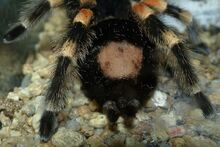
Adult female Brachypelma smithi, showing a bald patch after kicking hairs off of her abdomen.
Some tarantula species exhibit pronounced sexual dimorphism. Males tend to be smaller (especially their abdomens, which can appear quite narrow) and may be dull in color when compared to their female counterparts, as in the species Haplopelma lividum. Mature male tarantulas also may have tibial hooks on their front legs, which are used to restrain the female's fangs during copulation. Males typically have longer legs than the females.
A juvenile male's sex can be determined by looking at a cast exuvia for exiandrous fusillae or spermathecae. Females possess spermathecae except for the species Sickius longibulbi and Encyocratella olivacea. Males have much shorter lifespans than females because they die relatively soon after maturing. Few live long enough for a post ultimate molt, which is unlikely in natural habitats because they are vulnerable to predation, but has happened in captivity, though rarely. Most males do not live through this molt, as they tend to get their emboli, mature male sexual organs on pedipalps, stuck in the molt. Most tarantula fanciers regard females as more desirable as pets due to their much longer lifespans. Wild-caught tarantulas are often mature males because they wander out in the open and are more likely to be caught.
Lifecycle[]
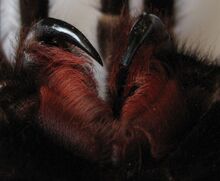
Lasiodora parahybana, cheliceraeof an adult female
Like other spiders, tarantulas have to shed their exoskeleton periodically to grow, a process called molting. A young tarantula may do this several times a year as a part of the maturation process, while full-grown specimens only molt once a year or less, or sooner, to replace lost limbs or lost urticating hairs. Clearly, molting will soon occur when the exoskeleton takes on a darker shade. If a tarantula previously used its urticating hairs, the bald patch turns from a peach color to deep blue. The tarantula also stops feeding and becomes more lethargic during this time.
Tarantulas may live for years; most species take two to five years to reach adulthood, but some species may take up to 10 years to reach full maturity. Upon reaching adulthood, males typically have but a 1.0- to 1.5-year period left to live and immediately go in search of a female with which to mate. Male tarantulas rarely molt again once they reach adulthood, but they may attempt to do so, usually becoming stuck during the molt due to their sexual organs and dying in the process.
Females continue to molt after reaching maturity. Female specimens have been known to reach 30 to 40 years of age, and have survived on water alone for up to 2 years. Grammostola rosea spiders are known for only eating once or twice a week and for living up to 20 years in captivity.
Reproduction[]
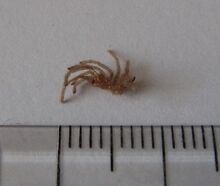
The molted skin of a juvenile Phormictopus cancerides cancerides (second molting)
As with other spiders, the mechanics of intercourse are quite different from those of mammals. Once a male spider reaches maturity and becomes motivated to mate, it weaves a web mat on a flat surface. The spider then rubs its abdomen on the surface of this mat, and in so doing, releases a quantity of semen. It may then insert its pedipalps (short, leg-like appendages between the chelicerae and front legs) into the pool of semen. The pedipalps absorb the semen and keep it viable until a mate can be found. When a male spider detects the presence of a female, the two exchange signals to establish that they are of the same species. These signals may also lull the female into a receptive state. If the female is receptive, then the male approaches her and inserts his pedipalps into an opening in the lower surface of her abdomen, called the opisthosoma. After the semen has been transferred to the receptive female's body, the male swiftly leaves the scene before the female recovers her appetite. Although females may show some aggression after mating, the male rarely becomes a meal.
Females deposit 50 to 2000 eggs, depending on the species, in a silken egg sac and guard it for 6 to 8 weeks. During this time, the females stay very close to the egg sacs and become more aggressive. Within most species, the females turn the egg sac often, which is called brooding. This keeps the eggs from deforming due to sitting in one position too long. The young spiderlings remain in the nest for some time after hatching, where they live off the remains of their yolk sacs before dispersing.
Taxonomy[]
Linnaeus placed all spiders in a single genus, Aranea. In 1802, Charles Athanase Walckenaer separated mygalomorph spiders into a separate genus, Mygale, leaving all other spiders in Aranea. However, Mygale had already been used in 1800 by Georges Cuvier for a genus of mammals (in Greek, mygale means "shrew"). Accordingly, in 1869, Tamerlan Thorell used the family name "Theraphosoidae" (modern Theraphosidae) for the mygalomorph spiders known to him, rather than "Mygalidae" (as used, for example, by John Blackwall). Thorell later split the family into a number of genera, including Theraphosa.

